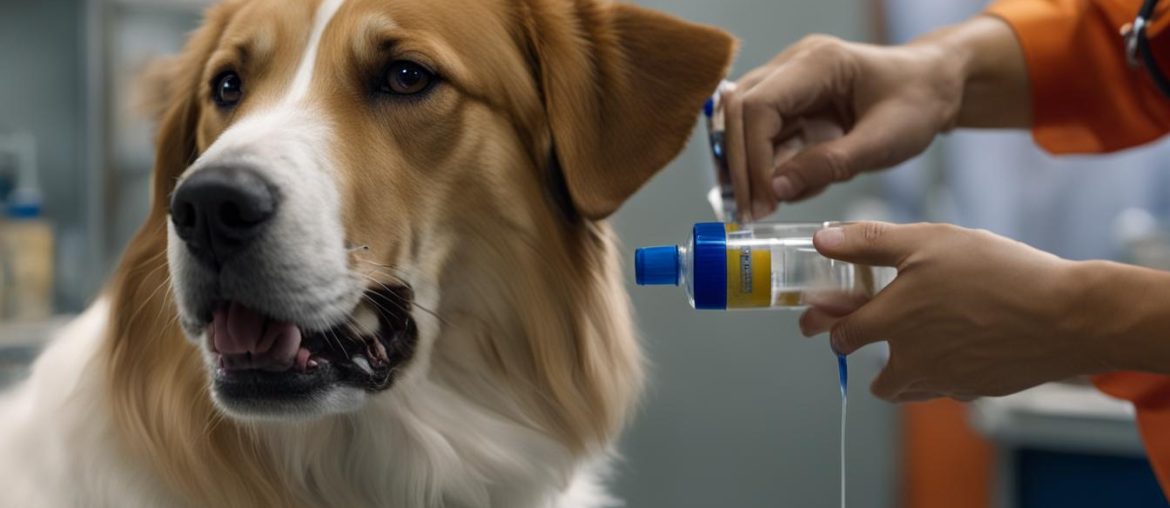Administering medication to dogs can be challenging, but it is essential for their well-being. This article will provide you with veterinary-approved techniques and step-by-step guidance on how to efficiently give liquid medicine to your dog. The tips and best practices mentioned here have been compiled from reputable sources in the veterinary field.
Key Takeaways:
- Follow veterinary-approved techniques for administering liquid medicine to dogs.
- Consult with your veterinarian for specific instructions and guidance.
- Be patient and calm while giving medication to your dog.
- Consider using alternative methods like compounding pharmacies if your dog refuses medication.
- Ensure your dog receives the medication they need to stay healthy and happy.
Tips for Administering Pet Medicine Effectively

Administering medication to pets can be a daunting task, especially when it comes to liquid medicine. However, with the right approach, it can be done effectively. Here are some tips to help you administer pet medicine efficiently:
- Choose a quiet and comfortable environment: Find a calm space where your pet feels relaxed and secure. This will make the administration process smoother and less stressful for both of you.
- Use positive reinforcement: Reward your pet with treats, praise, and gentle strokes after giving them their medication. This will create a positive association with the experience and make them more cooperative in the future.
- Follow the veterinarian’s instructions: Make sure you understand the dosage and administration instructions provided by your veterinarian. Pay attention to the recommended frequency and duration of the medication to ensure your pet receives the proper treatment.
- Start with a small amount: If your pet is hesitant or resistant to taking medication, start with a small amount to gauge their tolerance. Gradually increase the dosage over time as they become more accustomed to the process.
Remember, consistency and patience are key when administering medication to pets. It may take some trial and error to find the best technique that works for your pet, so don’t get discouraged if it doesn’t go smoothly at first. Consult with your veterinarian for additional guidance and support throughout the process.
Tips for Giving Liquid Medicine to Dogs:
Here are some specific tips for giving liquid medicine to dogs:
- Use a syringe or dropper: Measure the correct dosage of liquid medication using a syringe or dropper provided by your veterinarian. This allows for precise administration and ensures your dog receives the correct amount.
- Mix with food: If your dog is reluctant to take medication directly, try mixing the liquid medication with a small amount of their favorite wet food. This can mask the taste and make it more appealing to your dog.
- Administer from the side of the mouth: Gently lift your dog’s upper lip and administer the medication towards the back of their mouth, aiming for the space between the cheek and teeth. This helps prevent choking and ensures the medication is swallowed properly.
By following these tips and techniques, you can make the process of administering pet medicine more manageable and less stressful for both you and your furry friend.
Techniques for Administering Pills to Dogs
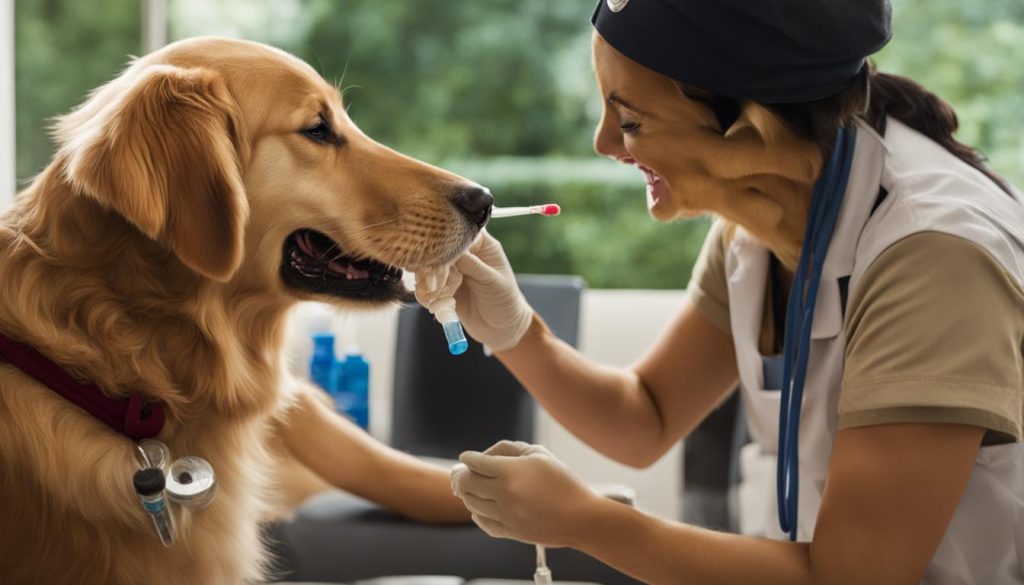
Administering pills to dogs can be challenging, but with the right techniques, it can become easier. Here are some techniques for giving pills to dogs:
1. Hide the pill in food:
One of the simplest ways to give pills to dogs is by hiding them in their food. You can use a soft treat, such as cheese or peanut butter, and hide the pill inside. Make sure to give your dog some plain treats before and after to ensure they swallow the pill.
2. Use a pill dispenser:
A pill dispenser is a device designed specifically for giving pills to dogs. It is a plastic or rubber tool that holds the pill and allows you to place it directly at the back of the dog’s throat. This ensures that the dog swallows the pill without spitting it out.
3. Crush the pill and mix it with food:
If your dog refuses to take a whole pill, you can crush it into a fine powder and mix it with a small amount of wet food. Ensure that your dog consumes the entire mixture to receive the full dosage of the medication.
4. Ask your veterinarian for a flavored pill:
Some medications are available in flavored forms that are more appealing to dogs. Talk to your veterinarian about the possibility of getting a flavored pill for easier administration.
| Technique | Pros | Cons |
|---|---|---|
| Hide the pill in food | – Easy to implement – Can be effective for dogs with strong food motivation |
– Some dogs may detect and spit out the pill – Not suitable for dogs with dietary restrictions or allergies to certain foods |
| Use a pill dispenser | – Allows precise placement of the pill in the back of the dog’s throat – Reduces the risk of the dog spitting out the pill |
– Some dogs may resist the use of a pill dispenser – Requires confidence and skill to use correctly |
| Crush the pill and mix it with food | – Easier for the dog to consume – Can mask the taste of the medication |
– May alter the absorption rate of the medication – Not suitable for all types of medications |
| Ask your veterinarian for a flavored pill | – More appealing to dogs – Reduces the need for additional administration techniques |
– Not all medications are available in flavored forms – May be more expensive than regular pills |
Remember, always consult with your veterinarian for specific instructions on administering pills to your dog. They can provide guidance tailored to your dog’s individual needs and ensure that the medication is being properly administered.
Techniques for Administering Pills to Cats
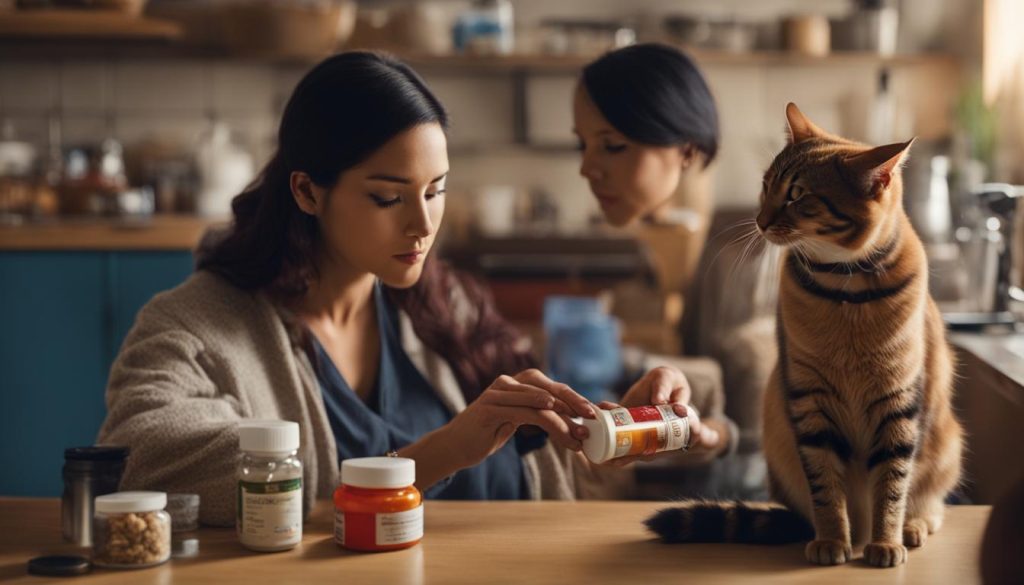
Administering pills to cats can be a challenging task, but with the right techniques and approach, it can become easier and less stressful for both you and your feline friend. Here are some effective techniques to help you successfully give pills to your cat:
1. Pill Pockets
Using pill pockets is a popular method for giving pills to cats. These specially designed treats have a small pocket where you can hide the pill. Cats are often more willing to eat a treat than take a pill directly, making this technique a convenient option. Make sure to choose pill pockets that are appropriate for your cat’s size and dietary needs.
2. Gentle Restraint
Restraint is often necessary when giving pills to cats. Gently restrain your cat by wrapping them in a towel or blanket, ensuring that their paws are secure. This will help prevent scratching and biting during the administration process. Be careful not to restrain your cat too tightly, as it may cause distress.
3. Pill Dispenser
A pill dispenser is a tool designed to hold the pill securely while allowing you to easily place it in your cat’s mouth. Simply place the pill inside the dispenser, open your cat’s mouth, and insert the dispenser towards the back of their throat. This technique ensures accurate pill placement while minimizing the risk of injury.
Remember, it’s important to consult with your veterinarian for specific instructions and guidance on administering pills to your cat. They may provide additional tips and techniques based on your cat’s individual needs and temperament.
Table: Comparison of Techniques for Administering Pills to Cats
| Technique | Advantages | Disadvantages |
|---|---|---|
| Pill Pockets | Convenient and appealing to cats, easy to administer | May not work for cats who are picky eaters or have dietary restrictions |
| Gentle Restraint | Provides control and safety during the administration process | May cause stress or discomfort for some cats |
| Pill Dispenser | Accurate pill placement, minimizes the risk of injury | Requires practice to master the technique |
Each technique has its advantages and disadvantages, and the best approach may vary depending on your cat’s preferences and behavior. If one technique doesn’t work, don’t get discouraged. It may take some trial and error to find the method that works best for your cat. Remember to reward your cat with praise and treats after successfully administering the pill to create a positive association with the process.
Administering Liquid Medications to Dogs
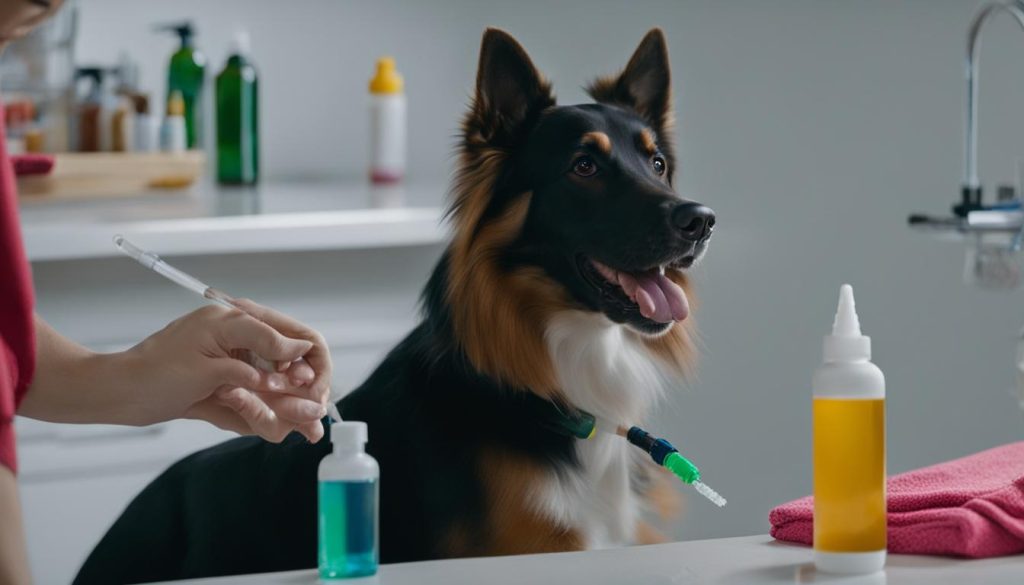
When it comes to administering liquid medications to dogs, there are a few techniques and best practices to keep in mind to ensure a smooth process. Here are some tips to help you give liquid medicine to your furry friend:
- Start by preparing the medication and gathering any necessary supplies. This may include a syringe or dropper provided by your veterinarian.
- Make sure to read the instructions carefully and follow the recommended dosage. It’s important to give the correct amount of medication to your dog.
- To make the process easier, try mixing the liquid medication with a small amount of your dog’s favorite treat or soft food. This can help mask the taste and make it more appealing to your pet.
- It’s crucial to approach your dog calmly and gently. You can try sitting on the floor with your dog or having them sit in a comfortable position if they are cooperative.
- Using the syringe or dropper, slowly and carefully insert the medication into your dog’s mouth. Aim for the back of the tongue to prevent them from spitting it out.
- Once the medication is administered, reward your dog with praise, treats, or a small play session to positively reinforce the experience.
Remember, every dog is different, and what works for one may not work for another. If you’re having difficulty giving your dog liquid medication, it’s always best to consult with your veterinarian for further guidance and assistance.
Administering liquid medications to dogs can be challenging, but with patience and the right techniques, it can become a manageable task. By following these tips and practicing gentle handling, you can ensure that your dog receives the necessary medications without unnecessary stress.
Table: Common Mistakes to Avoid
| Mistake | Explanation |
|---|---|
| Administering too quickly | Rapidly administering the medication can cause your dog to choke or gag. It’s important to take your time and go at a pace that your dog is comfortable with. |
| Not properly measuring the dosage | Accurately measuring the dosage is crucial for your dog’s safety and effectiveness of the medication. Use a syringe or dropper provided by your veterinarian to ensure precise measurements. |
| Not mixing the medication properly | If your dog dislikes the taste of the medication, it may refuse to take it. Mixing the medication with a small amount of food can make it more palatable for your dog. |
| Administering medication when your dog is stressed or anxious | Dogs may be less cooperative when they are anxious or stressed. Wait for a calmer moment to administer the medication, or try using gentle calming techniques to help relax your dog. |
Remember to always consult with your veterinarian for specific instructions and guidance on administering liquid medications to your dog. They can provide you with personalized advice based on your dog’s individual needs.
Tips for Administering Liquid Medications to Cats
Administering liquid medications to cats can be more challenging than giving pills due to their size and temperament. However, with the right techniques and approach, it is possible to successfully give liquid medicine to your feline friend. Here are some tips to help you navigate the process:
- Choose the right medication: Speak to your veterinarian about whether a liquid formulation is the best option for your cat. Some medications may be available in pill form or as flavored liquids that are more palatable to cats.
- Use a syringe: Administering liquid medications using a syringe can give you more control and accuracy. Draw up the prescribed dose into the syringe, remove the needle, and then gently place the tip of the syringe into the side of your cat’s mouth, squirting the medication slowly to avoid choking.
- Be patient and calm: It’s important to approach the process with patience and a calm demeanor. Cats are sensitive to their owners’ energy, so if you are stressed or anxious, it may make the process more difficult. Take your time, speak soothingly to your cat, and reward them with treats or praise after successfully administering the medication.
Remember, always consult with your veterinarian for specific instructions and guidance tailored to your cat’s needs. They can provide additional tips and techniques based on your cat’s individual temperament and medical condition. With persistence and a gentle approach, you can ensure that your cat receives the necessary medication for their health and well-being.
Example Table: Common Liquid Medications for Cats
| Medication Name | Indication | Dosage | Administration |
|---|---|---|---|
| Felodipine | Hypertension | 2.5 mg – 10 mg | Oral, with or without food |
| Metronidazole | Bacterial infections, giardia | 5 mg – 10 mg | Oral, with or without food |
| Lactulose | Constipation | 1 ml – 5 ml | Oral, mixed with food or directly into the mouth |
Table: Common Liquid Medications for Cats
Tips for Administering Pet Medicine Effectively
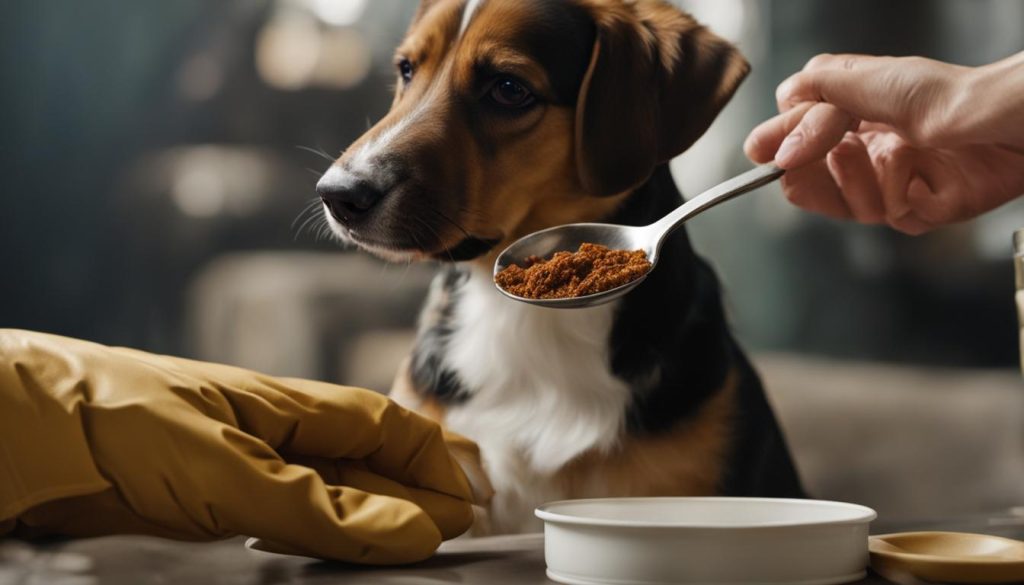
Administering medication to our furry friends can sometimes be a challenging task, but with the right techniques and best practices, you can make the process smoother and less stressful. Here are some tips for giving liquid medicine to dogs and administering medication to them:
1. Create a Calm and Comfortable Environment
Find a quiet and comfortable space where you can administer the medication to your dog. Eliminate any distractions, such as loud noises or other pets, that may cause anxiety or agitation. This will help create a calm environment and make the experience more pleasant for your dog.
2. Use Positive Reinforcement
Positive reinforcement is a powerful tool when it comes to giving medication to dogs. Reward your dog with treats, praise, or a favorite toy before and after administering the medication. This will help build a positive association and make it easier to administer medication in the future.
3. Get Your Dog Accustomed to Handling
Start getting your dog used to being handled and touched around the mouth and face area. Gently touch their lips, gums, and teeth to desensitize them to the sensation. Gradually introduce the medication process by placing a small amount of flavored liquid on their lips or tongue using a syringe. Repeat this process daily to familiarize your dog with the taste and sensation of the medication.
4. Choose the Right Administration Technique
There are different techniques for administering liquid medication to dogs. Some common methods include using a syringe to squirt the medication into the back of the cheek, mixing it with a small amount of food, or using a special medication dispenser designed for pets. Consult with your veterinarian to determine the most suitable technique for your dog.
| Technique | Description |
|---|---|
| Syringe Method | Using a syringe, place the medication in the back of the cheek and gently squeeze. Ensure your dog swallows the medication. |
| Mixing with Food | Mix the medication with a small amount of your dog’s favorite food. Ensure they consume the entire dose. |
| Medication Dispenser | Use a specialized medication dispenser designed for pets to administer the liquid medication. |
Remember, always follow your veterinarian’s instructions and dosage guidelines when administering medication to your dog. If you have any concerns or difficulties, don’t hesitate to reach out to your veterinarian for further guidance.
Benefits of a Compounding Pharmacy

When it comes to giving liquid medicine to dogs, taste can often be a major obstacle. Some medications have strong flavors that dogs may find unappealing, leading to resistance and difficulty in administering the medication. This is where a compounding pharmacy can make a significant difference. By working with a compounding pharmacy, you can have the medication specially formulated to suit your dog’s taste preferences and make it more palatable.
Compounding pharmacies have the ability to add flavors, such as beef or chicken, to the medication, making it more appealing to dogs. This helps to eliminate the struggle of coaxing your dog to take their medicine, reducing stress for both you and your pet. Additionally, compounding pharmacies can customize the dosage form to suit your dog’s needs, whether it be a liquid, chewable tablet, or transdermal gel, making it easier to administer.
Another benefit of a compounding pharmacy is the ability to combine multiple medications into a single dose. This can be particularly beneficial if your dog requires multiple medications to be given simultaneously. By combining them into one dose, you can simplify the medication administration process, making it more convenient for both you and your pet.
| Benefits of a Compounding Pharmacy |
|---|
| Customized flavor options |
| Customized dosage form |
| Ability to combine multiple medications |
It is important to consult with your veterinarian and discuss the option of using a compounding pharmacy for your dog’s medication. They can provide guidance on the best approach and ensure that the medication is formulated correctly to meet your dog’s specific needs. Remember, the goal is to make the medication administration process as stress-free and efficient as possible, and a compounding pharmacy can be a valuable resource in achieving this.
Wrapping Up
Administering liquid medicine to dogs can be challenging, but with the right techniques and approaches, it can become easier and less stressful for both you and your pet. By following the tips and best practices outlined in this article, you can ensure that your furry friend receives the medication they need to stay healthy and happy.
Remember to always consult with your veterinarian for specific instructions and guidance tailored to your dog’s needs. They can provide valuable insights and address any concerns you may have regarding your dog’s medication administration.
Incorporating these techniques into your routine can make the process more efficient and minimize any potential resistance from your dog. The key is to be patient and gentle, creating a positive and stress-free environment for medication administration. With practice and consistency, you’ll become more proficient in giving liquid medicine to your dog, ensuring their well-being and recovery.
FAQ
How can I give liquid medicine to my dog efficiently?
There are several techniques you can use to administer liquid medicine to dogs. Some options include mixing it with their food, using a syringe or dropper, or placing it directly into their mouth. It’s important to consult with your veterinarian for specific instructions tailored to your dog’s needs.
What are some tips for giving liquid medicine to dogs?
Here are some tips for giving liquid medicine to dogs: make sure the medicine is at room temperature, use a syringe or dropper for precise measurement, gently hold their mouth open, aim for the back of the tongue, and reward them with a treat or praise afterwards. It’s important to be patient and calm during the process.
How can I give pills to dogs?
Giving pills to dogs can be challenging, but there are techniques you can use to make it easier. Some options include hiding the pill in their food, using pill pockets or treats designed for medication, or wrapping the pill in a soft treat. It’s important to ensure they swallow the pill and not spit it out.
What are some techniques for giving pills to cats?
Giving pills to cats can be more challenging due to their size and temperament. Some techniques you can try include wrapping them in a towel to restrain them, using a pill dispenser or pill gun, or crushing the pill and mixing it with their food. It’s important to be cautious and gentle when handling cats.
How should I administer liquid medications to dogs?
Administering liquid medications to dogs requires a different approach than pills. Here are some tips for giving liquid medications to dogs: hold them securely, tilt their head back slightly, insert the syringe or dropper into the side of their mouth, and slowly dispense the medication. It’s important to avoid squirting the medicine down their throat.
What are some tips for giving liquid medications to cats?
Administering liquid medications to cats can be more challenging due to their size and temperament. Some tips for giving liquid medications to cats include wrapping them in a towel to restrain them, using a syringe or dropper to slowly administer the medication, and rewarding them with a treat or praise afterwards. It’s important to be patient and gentle during the process.
What should I do if my pet refuses medication using the previous techniques?
If your pet refuses medication using the previous techniques, there are additional techniques you can try. Some options include mixing the medication with a small amount of tasty food, using a pet pill dispenser, or asking your veterinarian for alternative medication forms, such as a transdermal gel or flavored chewable tablets.
How can a compounding pharmacy help if my pet refuses medication due to the taste?
If your pet refuses medication due to the taste, a compounding pharmacy can be a great solution. They can customize the medication by adding flavors that your pet finds more palatable. This can make the medication more appealing and easier to administer.
What are the benefits of using a compounding pharmacy for pet medication?
Using a compounding pharmacy for pet medication has several benefits. They can customize the medication to meet your pet’s specific needs, such as adjusting the dosage or formulating it without certain allergens. This can make it easier for you to administer the medication and ensure your pet receives the proper treatment.


